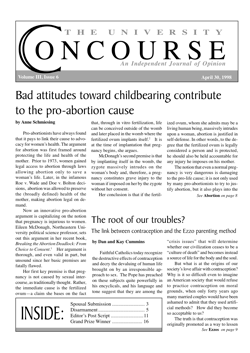Bad attitudes toward childbearing contribute to the pro-abortion cause
by Anne Schmiesing
Pro-abortionists have always found that it pays to link their cause to advocacy for women’s health. The argument for abortion was first framed around protecting the life and health of the mother. Prior to 1973, women gained legal access to abortion through laws allowing abortion only to save a woman’s life. Later, in the infamous Roe v. Wade and Doe v. Bolton decisions, abortion was allowed to preserve the (broadly defined) health of the mother, making abortion legal on demand.
Now an innovative pro-abortion argument is capitalizing on the notion that pregnancy is injurious to women. Eileen McDonagh, Northeastern University political science professor, sets out this argument in her recent book, Breaking the Abortion Deadlock: From Choice to Consent.1 Her argument is thorough, and even valid in part, but unsound since her basic premises are fatally flawed.
Her first key premise is that pregnancy is not caused by sexual intercourse, as traditionally thought. Rather, the immediate cause is the fertilized ovum—a claim she bases on the fact that, through in vitro fertilization, life can be conceived outside of the womb and later placed in the womb where the fertilized ovum implants itself.2 It is at the time of implantation that pregnancy begins, she argues.
McDonagh’s second premise is that by implanting itself in the womb, the zygote massively intrudes on the woman’s body and, therefore, a pregnancy constitutes grave injury to the woman if imposed on her by the zygote without her consent.
Her conclusion is that if the fertilized ovum, whom she admits may be a living human being, massively intrudes upon a woman, abortion is justified in self-defense. In other words, to the degree that the fertilized ovum is legally considered a person and is protected, he should also be held accountable for any injury he imposes on his mother.
The notion that even a normal pregnancy is very dangerous is damaging to the pro-life cause; it is not only used by many pro-abortionists to try to justify abortion, but it also plays into the decisions of many women to abort their babies. It is therefore vitally important that we as pro-lifers expose the falsehood of these claims, and, evenmore, promote a more positive view of pregnancy.
McDonagh, for her purpose of justifying abortion, grossly exaggerates the changes in a woman’s body and the dangers of pregnancy, but her argument is even more effective because it falls on the fertile soil of contemporary American culture, in which an attitude of fear toward bearing children (both in pregnancy and childbirth) has been prevalent for many years.
Normal pregnancy is usually accompanied by some discomforts, the kind and degree of which are as varied as the women experiencing them. Some, but not all of the discomfort (e.g. morning sickness), can be tempered or even prevented by good nutritional intake, good hygiene and exercise. This normal discomfort is to be distinguished from dangers of pregnancy. If complications do arise during a pregnancy, then that pregnancy may be considered dangerous, but a normal pregnancy is not dangerous in itself.
Something is considered “dangerous” if the probability of complications is high; pregnancy does not fit into this category. The risks of a normal pregnancy are relatively low. Similarly, eating is not considered dangerous although it carries the risk of choking or food poisoning. Certain health conditions, however, can exist that may increase the risks of eating. The same is the case for pregnancy.
The maternal mortality rate in the United States is very low, less that one death per 10,000 live births.3 And the number of non-fatal complications from hereditary or natural causes are much fewer than one might expect. Some seemingly natural complications can be caused by unneccesary interventions. Were women to understand that such complications are not as common as they may seem, they would not fear pregnancy and childbirth as much, and abortion supporters would not be able to use the argument that “every pregnancy puts a woman at risk,” to justify abortion.
Pregnancy and childbirth are normal and natural processes for a woman. A woman’s body is formed to sustain pregnancy. If she is unable to sustain the life conceived within and the pregnancy ends in miscarriage, it is not normal; something has gone wrong. Similarly, if pregnancy causes severe physical problems for the woman, something is wrong.
Unfortunately, many people, including many doctors, do not see pregnancy as a normal process. They treat pregnancy and childbirth as if it were a very dangerous time for both mother and child. If a mother is influenced by this philosophy, she will fear the pregnancy, and her tension may actually cause the very thing she fears—pain and complications.
Fear of childbirth may also lead to many unnecessary interventions in pregnancy and labor, which in turn cause additional complications.4 As Diana Korte and Roberta Scaer, authors of A Good Birth, A Safe Birth found in their research, there is less chance of complication during pregnancy if a woman and her birth attendant hold “the belief that intervention should be used only when the need is greater than the risk.”5 Some interventions, however, are used almost routinely. When society treats even a normal pregnancy as an illness or disease—requiring interventions, medical treatment and even hospitalization—we lend credence to the pro-abortionists’ claim that pregnancy constitutes grave injury to a woman, and at the same time exacerbate the fears some women have of childbirth, which may in turn lead them to choose abortion. We contribute to the arguments of people like Professor McDonagh to try to justify abortion.
Anne (Lodzinski, ‘96) Schmiesing is employed as Program Director for Pennsylvanians for Human Life in Philadelphia.
- For a good critique of this book see review by Frederica Mathewes-Green in National Right To Life News, August 12, 1997. ↑
- McDonagh fails to consider that regardless of he means by which one becomes pregnant, an agent distinct from and independent of the fertilized ovum is necessary. No one can become pregnant or bring a zygote into being (enabling it to subsequently “commit the crime” of injuring his mother) without having taken some proactive steps to conceive (except by means of rape or divine intervention). ↑
- New York: Bantam Books, (1990), 56. ↑
- I in no way mean to imply that all complications are caused by abuses on the part of the mother, prenatal caregiver or birth attendant. ↑
- Korte and Scaer, 59. One example of an intervention that causes complications is the use of a fetal monitor during labor which limits the movement of a woman, increasing the chance of poor positioning of the baby or lack of progress in labor, both of which may lead to an otherwise unnecessary cesarean section. ↑


